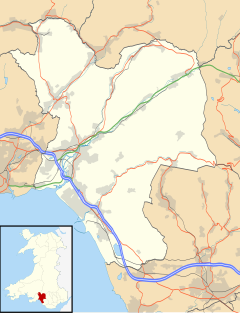Margam
| Margam | |
|---|---|
| Margam shown within Neath Port Talbot | |
| Population | 3,017 (2011 census) |
| OS grid reference | SS803854 |
| Principal area | |
| Ceremonial county | |
| Country | Wales |
| Sovereign state | United Kingdom |
| Post town | PORT TALBOT |
| Postcode district | SA13 |
| Dialling code | 01639 |
| Police | South Wales |
| Fire | Mid and West Wales |
| Ambulance | Welsh |
| EU Parliament | Wales |
| UK Parliament | |
| Welsh Assembly | |
| Councillors |
|
Margam is a suburb of Port Talbot in the Welsh county borough of Neath Port Talbot, Wales, close to junction 39 of the M4 motorway.
Margam was an ancient Welsh community, formerly part of the cwmwd of Tir Iarll, initially dominated by Margam Abbey, a wealthy house of the Cistercians founded in 1147. (Margam is believed to have played a significant role in the early transmission of the work of St. Bernard of Clairvaux). At the dissolution of the monasteries, it came into the possession of the Mansel family who were eventually succeeded by their descendants in the female line, the Talbot family, a cadet branch of the family of the Earls of Shrewsbury.
The parish church continued to operate from the nave of Margam Abbey, as it still does. Margam Castle grounds contain the ruins of the Chapter House and major 17th century and 18th century monuments. The Stones Museum contains important evidence for the advent of early Christianity in the area.
With the coming of the industrial revolution, the parish of Margam became important for two reasons. First, it had a good harbour which was ultimately developed into Port Talbot, named in honour of the squires of Margam. Second, it had coal deposits, and coal mining in the parish took off in the late 18th century. The combination of local fuel and good transport links from the harbour made Margam an important part of the industrial landscape of the South Wales Coalfield.
...
Wikipedia

